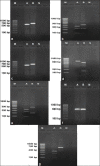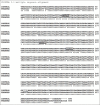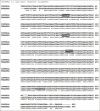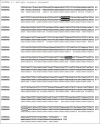Mutagenicity Assessment of Organophosphates using Polymerase Chain Reaction-Restriction Fragment Length Polymorphism Assay
- PMID: 24403735
- PMCID: PMC3877493
- DOI: 10.4103/0971-6580.121678
Mutagenicity Assessment of Organophosphates using Polymerase Chain Reaction-Restriction Fragment Length Polymorphism Assay
Abstract
Objectives: In this study we have evaluated the mutagenicity of organophosphate pesticides acephate, chlorpyrifos, and profenofos using polymerase chain reaction-restriction fragment length polymorphism (PCR-RFLP) assay with the mosquito Culex quinquefasciatus taken as an experimental model.
Materials and methods: Second instar larvae were treated with LC20 of each pesticide for 24 h and mutations induced in the sequence of mitochondrial COII gene (690bp) were studied from restriction patterns generated with AluI, PacI, and PsiI restriction endonucleases.
Results: Variations in the number and size of digested fragments were recorded from treated individuals compared with controls showing that the restriction enzymes created a cut at different locations. In addition, sequences of COII gene from control and treated individuals were also used to confirm the RFLP patterns. From the sequence alignment data, it was found that mutations caused the destruction and generation of restriction sites in the gene sequence of treated individuals.
Conclusion: This study indicates that all the three pesticides had potential to induce mutations in the normal sequence of COII gene and also advocates the use of PCR-RFLP assay as an efficient, rapid, and sensitive technique to detect mutagenicity of pesticides.
Keywords: Acephate; Cx. quinquefasciatus; PCR-RFLP; chlorpyrifos; mutagenicity; profenofos.
Conflict of interest statement
Figures




Similar articles
-
Genotoxicity Evaluation of Acephate and Profenofos by the PCR-RFLP Assay.Toxicol Int. 2014 Jan;21(1):84-8. doi: 10.4103/0971-6580.128809. Toxicol Int. 2014. PMID: 24748740 Free PMC article.
-
Development of a multiplexed polymerase chain reaction-restriction fragment length polymorphism (PCR-RFLP) assay to identify common members of the Subgenera Culex (Culex) and Culex (Phenacomyia) in Guatemala.Am J Trop Med Hyg. 2010 Aug;83(2):285-91. doi: 10.4269/ajtmh.2010.10-0077. Am J Trop Med Hyg. 2010. PMID: 20682869 Free PMC article.
-
Evaluation of toxic potential of acephate and chlorpyrifos by dominant lethal test on Culex quinquefasciatus.J Environ Biol. 2013 May;34(3):573-7. J Environ Biol. 2013. PMID: 24617144
-
Restriction fragment length polymorphism analysis for rapid gag subtype determination of human immunodeficiency virus type 1 in South Africa.J Virol Methods. 1999 Mar;78(1-2):51-9. doi: 10.1016/s0166-0934(98)00163-3. J Virol Methods. 1999. PMID: 10204696
-
Characterisation of taeniid cestode species by PCR-RFLP of ITS2 ribosomal DNA.Acta Trop. 1995 Mar;59(1):31-40. doi: 10.1016/0001-706x(94)00085-f. Acta Trop. 1995. PMID: 7785524 Review.
Cited by
-
Nitraria retusa fruit prevents penconazole-induced kidney injury in adult rats through modulation of oxidative stress and histopathological changes.Pharm Biol. 2017 Dec;55(1):1061-1073. doi: 10.1080/13880209.2016.1278455. Pharm Biol. 2017. PMID: 28198206 Free PMC article.
References
-
- Costa LG. Current issues in organophosphate toxicology. Clin Chim Acta. 2006;366:1–13. - PubMed
-
- Shadnia S, Azizi E, Hosseini R, Khoei S, Fouladdel S, Pajoumand A, et al. Evaluation of oxidative stress and genotoxicity in organophosphorus insecticide formulators. Hum Exp Toxicol. 2005;24:439–45. - PubMed
-
- Joshi SC, Mathur R, Gulati N. Testicular toxicity of chlorpyrifos (an organophosphate pesticide) in albino rats. Toxicol Ind Health. 2007;23:439–44. - PubMed
-
- Siddique HR, Chowdhuri DK, Saxena DK, Dhawan A. Validation of Drosophila melanogaster as an in vivo model for genotoxicity assessment using modified alkaline Comet assay. Mutagenesis. 2005;20:285–90. - PubMed
-
- Gupta SC, Mishra M, Sharma A, Deepak Balaji TG, Kumar R, Mishra RK, et al. Chlorpyrifos induces apoptosis and DNA damage in Drosophila through generation of reactive oxygen species. Ecotoxicol Environ Saf. 2010;73:1415–23. - PubMed
LinkOut - more resources
Full Text Sources
Other Literature Sources

